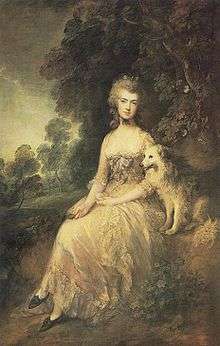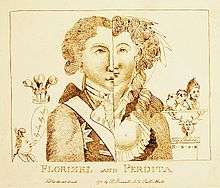Mary Robinson (poet)
| Mary Robinson | |
|---|---|
 Portrait of Mary Robinson by Thomas Gainsborough, 1781 | |
| Born |
Mary Darby 27 November 1757 England |
| Died |
26 December 1800 (aged 43) England |
Mary Robinson (née Darby) (27 November 1757? – 26 December 1800) was an English actress, poet, dramatist, novelist, and celebrity figure. During her lifetime she was known as "the English Sappho".[1][2] She earned her nickname "Perdita" for her role as Perdita (heroine of Shakespeare's The Winter's Tale) in 1779. She was the first public mistress of King George IV while he was still Prince of Wales.
Biography
Early life
Robinson was born in Bristol, England to John Darby, a naval captain, and his wife Hester (née Seys). In her memoirs,[3] Robinson gives her birth in 1758 but the year 1757 seems more likely according to recently published research (see appendix to Byrne, 2005). Her father deserted her mother and took on a mistress when Robinson was still a child. The family hoped for a reconciliation, but Captain Darby made it clear that this was not going to happen. Without the support of her husband, Hester Darby supported herself and the five children born of the marriage by starting a school for young girls in Little Chelsea, London, (where Robinson taught by her 14th birthday).[4] However, during one of his brief returns to the family, Captain Darby had the school closed[5] (which he was entitled to do by English law). Robinson, who at one point attended a school run by the social reformer Hannah More, came to the attention of actor David Garrick.
Marriage
Hester Darby encouraged her daughter to accept the proposal of an articled clerk, Thomas Robinson, who claimed to have an inheritance. Mary was against this idea; however, after being stricken ill, and watching him take care of her and her younger brother, she felt that she owed him, and she did not want to disappoint her mother who was pushing for the engagement. After the early marriage, Robinson discovered that her husband did not have an inheritance. He continued to live an elaborate lifestyle, however, and had multiple affairs that he made no effort to hide. Subsequently, Mary supported their family. After her husband squandered their money, the couple fled to Talgarth, Wales (where Robinson's only daughter, Mary Elizabeth, was born in November). Here they lived in a fairly large estate, called Tregunter Park. Eventually Her husband was imprisoned for debt in the Fleet Prison where she accompanied him for many months.[6] During this time, Mary Robinson found a patron in Georgiana Cavendish, Duchess of Devonshire, who sponsored the publication of Robinson's first volume of poems, Captivity.
Theatre

After her husband obtained his release from prison, Robinson decided to return to the theatre. She launched her acting career and took to the stage, playing Juliet, at Drury Lane Theatre in December 1776. Robinson was best known for her facility with the 'breeches parts', her performances as Viola in William Shakespeare'sTwelfth Night and Rosalind in As You Like It won her extensive praise. But she gained popularity with playing in Florizel and Perdita, an adaptation of Shakespeare, with the role of Perdita (heroine of The Winter's Tale) in 1779. It was during this performance that she attracted the notice of the young Prince of Wales, later King George IV of the United Kingdom.[7] He offered her twenty thousand pounds to become his mistress.[8] With her new social prominence, Robinson became a trend-setter in London, introducing a loose, flowing muslin style of gown based upon Grecian statuary that became known as the Perdita. It took Robinson a considerable amount of time to decide to leave her husband for the Prince, as she did not want to be seen by the public as that type of woman. Throughout much of her life she struggled to live in the public eye and also to stay true to the values in which she believed. She eventually gave in to her desires to be with a man whom she thought would treat her better than Mr. Robinson. However, the Prince ended the affair in 1781, refusing to pay the promised sum.[9] "Perdita" Robinson was left to support herself through an annuity promised by the Crown (but rarely paid), in return for some letters written by the Prince, and through her writings.[10]
Later life and death
Mary Robinson, who now lived separately from her husband, went on to have several love affairs, most notably with Banastre Tarleton, a soldier who had recently distinguished himself fighting in the American War of Independence. Their relationship survived for the next 15 years, through Tarleton's rise in military rank and his concomitant political successes, through Mary's own various illnesses, through financial vicissitudes and the efforts of Tarleton's own family to end the relationship. They had no children, although Robinson had a miscarriage. However, in the end, Tarleton married Susan Bertie, an heiress and an illegitimate daughter of the young 4th Duke of Ancaster, and niece of his sisters Lady Willoughby de Eresby and Lady Cholmondeley.
In 1783, Robinson suffered a mysterious illness that left her partially paralysed. Biographer Paula Byrne speculates that a streptococcal infection resulting from a miscarriage led to a severe rheumatic fever that left her disabled for the rest of her life. From the late 1780s, Robinson became distinguished for her poetry and was called "the English Sappho". In addition to poems, she wrote eight novels, three plays, feminist treatises, and an autobiographical manuscript that was incomplete at the time of her death. Like her contemporary Mary Wollstonecraft, she championed the rights of women and was an ardent supporter of the French Revolution. She died in late 1800 in poverty at the age of 43, having survived several years of ill health, and was survived by her daughter, who was also a published novelist.
Literature
After years of scholarly neglect, Robinson's literary afterlife continues apace. While most of the early literature written about Robinson focused on her sexuality, emphasizing her affairs and fashions, she began to receive the attention of feminists and literary scholars in the 1990s. In addition to regaining literary and cultural notability, she has re-attained a degree of celebrity in recent years when several biographies of her appeared, including one by Paula Byrne entitled Perdita: The Literary, Theatrical, and Scandalous Life of Mary Robinson that became a top-ten best-seller after being selected for the Richard & Judy Book Club.
Poetry
- Poems (1775)
- Captivity, A Poem and Celadon and Lydia, a Tale (1777)
- Poems (Vol. 1, 1791 / Vol. 2, 1793)
- London's Summer Morning (1795)
- Sappho and Phaon: In a Series of Legitimate Sonnets (1796)
- Lyrical Tales (1800)
Novels
- Vancenza; or, The Dangers of Credulity (1792)
- The Widow; or, A Picture of Modern Times (1794)
- Angelina; A Novel (1796)
- Hubert de Sevrac, A Romance, of the Eighteenth Century (1796)
- Walsingham: or, The Pupil of Nature, A Domestic Story (1797)
- The False Friend; A Domestic Story (1799)
- The Natural Daughter. With Portraits of the Leadenhead Family. A Novel (1799)
- Jasper, A Fragment [published posthumously in Memoirs of the Late Mrs. Robinson, Written by Herself (1801)]
Dramas
- The Lucky Escape, A Comic Opera (Drury Lane, 1778)
- Nobody: A Comedy in Two Acts (Drury Lane, 1794)
- The Sicilian Lover: A Tragedy in Five Acts (never performed)
Socio-political texts
- Impartial Reflections of the Present Situation of the Queen of France (1791)
- A Letter to the Women of England, on the Injustice of Mental Subordination (1799)
Memoir
- Robinson, Mary [and Maria Elizabeth Robinson]. Memoirs of the Late Mrs. Robinson, Written by Herself. With Some Posthumous Pieces. 4 vols. London, 1801.
Biographies of Robinson
- Byrne, Paula. Perdita: The Literary, Theatrical, and Scandalous Life of Mary Robinson. New York: Random House, 2004.
-
 Chisholm, Hugh, ed. (1911). "Robinson, Mary". Encyclopædia Britannica. 23 (11th ed.). Cambridge University Press.
Chisholm, Hugh, ed. (1911). "Robinson, Mary". Encyclopædia Britannica. 23 (11th ed.). Cambridge University Press. - Davenport, Hester. The Prince’s Mistress: Perdita, a Life of Mary Robinson. Stroud: Sutton Publishing, 2004.
- Gristwood, Sarah. Perdita: Royal Mistress, Writer, Romantic. London: Bantam, 2005.
- Memoirs of Mary Robinson 1895.
-
 Knight, John Joseph (1897). "Robinson, Mary". In Lee, Sidney. Dictionary of National Biography. 49. London: Smith, Elder & Co.
Knight, John Joseph (1897). "Robinson, Mary". In Lee, Sidney. Dictionary of National Biography. 49. London: Smith, Elder & Co. - Ledoux, Ellen Malenas. “Florizel and Perdita Affair, 1779–80.” BRANCH: Britain, Representation and Nineteenth-Century History. Ed. Dino Franco Felluga. Extension of Romanticism and Victorianism on the Net. Web. 2 June 2013.
- Robinson, Mary [and Maria Elizabeth Robinson]. Memoirs of the Late Mrs. Robinson, Written by Herself. With Some Posthumous Pieces. 4 vols. London, 1801.
- Levy, Martin J. "Robinson, Mary [Perdita] (1756/1758?–1800)". Oxford Dictionary of National Biography (online ed.). Oxford University Press. doi:10.1093/ref:odnb/23857. (Subscription or UK public library membership required.)
Resources on Robinson and her literature
- Brewer, William D., ed. The Works of Mary Robinson. 8 vols. Pickering & Chatto, 2009–2010.
- Gamer, Michael, and Terry F. Robinson. “Mary Robinson and the Dramatic Art of the Comeback.” Studies in Romanticism 48.2 (Summer 2009): 219–256.
- Pascoe, Judith. Mary Robinson: Selected Poems. Peterborough, ON: Broadview Press, 1999.
- Robinson, Daniel. The Poetry of Mary Robinson: Form and Fame. New York: Palgrave Macmillan, 2011.
- Robinson, Terry F. "Introduction." Nobody. By Mary Robinson. Romantic Circles. Web. March 2013.
Fictional works about Robinson
- Elyot, Amanda. All For Love: The Scandalous Life and Times of Royal Mistress Mary Robinson. A Novel. 2008.
- Lightfoot, Freda. Lady of Passion: The Story of Mary Robinson. 2013.
- Plaidy, Jean. Perdita's Prince. 1969.
Notes
- ↑ Mary Robinson, Sappho and Phaon, About the Book
- ↑ Judith Pascoe, Romantic Theatricality, Cornell University Press, 1997, ISBN 0-8014-3304-5, p.13
- ↑ Her daughter Mary Elizabeth, honoring her mother's request, published a draft of Robinson's memoirs in 1801 as Memoirs, with some Posthumous Pieces,
- ↑ Levy 2004.
- ↑ Feldman, p. 590
- ↑ Smith, E.A (2001). George IV. The Pursuit of Pleasure. p. 17.
- ↑ Feldman, Paula R (2000). British Women Poets of the Romantic Era: An Anthology. Mary Robinson (1758–1800). p. 590. ISBN 0-8018-6640-5.
- ↑ Carroll, Leslie (2008). Royal Affairs: A Lusty Romp Through the Extramarital Adventures That Rocked the British Monarchy. George IV and Mary Robinson 1757–1800. ISBN 978-0-451-22398-2.
- ↑ See Katharine Binhammer, 'Thinking Gender with Sexuality in 1790s Feminist Thought'. Feminist Studies28.3 (2002): 667–690.
- ↑ Carroll (2008). Royal Affairs: A Lusty Romp Through the Extramarital Adventures That Rocked the British Monarchy. George IV and Mary Robinson 1757–1800.
References
- Binhammer, Katherine. 'Thinking Gender with Sexuality in 1790s Feminist Thought.' Feminist Studies 28.3 (2002): 667–90.
- Byrne, Paula (2005). Perdita: The Life of Mary Robinson. London: HarperCollins and New York: Random House.
- Gristwood, Sarah (2005). Perdita: royal mistress, writer, romantic. London: Bantam.
- Levy, Martin J. Biography of Mary Robinson, Oxford Dictionary of National Biography, Oxford University Press, 2004. Accessed 10 November 2006
- Robinson, Mary, and Mary Elizabeth Robinson (1801). Memoirs of the Late Mrs. Robinson. London: Printed by Wilkes and Taylor for R. Phillips.
- Mary Darby Robinson biography
- Mary Robinson memoirs
External links
| Wikimedia Commons has media related to Mary Robinson (poet). |
- Online books, and library resources in your library and in other libraries about Mary Robinson (poet)
- Online books, and library resources in your library and in other libraries by Mary Robinson (poet)
- Works by Mary Robinson at Project Gutenberg
- Works by or about Mary Robinson at Internet Archive
- Portrait of Mary Robinson by Gainsborough The Guardian, 26 August 2000
- Mary Robinson profile Contemporary obituaries and death notices Tarleton site